DOI: https://doi.org/10.1038/s41467-024-46022-3
PMID: https://pubmed.ncbi.nlm.nih.gov/38418862
تاريخ النشر: 2024-02-28
تصميم جزيئي وجهاز عقلاني يمكّن خلايا الشمس العضوية من الاقتراب من كفاءة 20%
تم القبول: 12 فبراير 2024
نُشر على الإنترنت: 28 فبراير 2024
(أ) التحقق من التحديثات
الملخص
لكي تكون خلايا الشمسية العضوية تنافسية، يجب أن تلبي الجزيئات الممتصة للضوء في الوقت نفسه عدة متطلبات رئيسية، بما في ذلك حالة نقل الشحنة ذات الامتصاص الضعيف، وثابت العزل العالي، وطاقة السطح المناسبة، والبلورية المناسبة، وما إلى ذلك. ومع ذلك، فإن القاعدة التصميمية المنهجية في الجزيئات لتحقيق الأهداف المذكورة أعلاه نادراً ما تم دراستها. في هذا العمل، وبإرشاد من الحسابات النظرية، نقدم تصميمًا عقلانيًا لمستقبل غير فوليرين o-BTP-eC9، مع خصائص ضوئية وكهربائية مميزة مقارنةً بـ BTP-eC9 القياسي. لقد رفع جهاز قائم على o-BTP-eC9 حالة نقل الشحنة، مما يقلل بشكل كبير من فقدان الطاقة بمقدار 41 ميلي فولت ويظهر كفاءة تحويل طاقة ممتازة.
وزيادة كفاءة الكم للإضاءة الكهروضوئية (
النتائج
الحسابات النظرية والخصائص الجوهرية لجزيء الهدف
تأثير توزيع الإلكترونات في مستوى LUMO لجزيء NFA. وفقًا لآلية اقتراض الشدة، فإن رفع مستوى LUMO لجزيء NFA هو وسيلة فعالة لتقليل
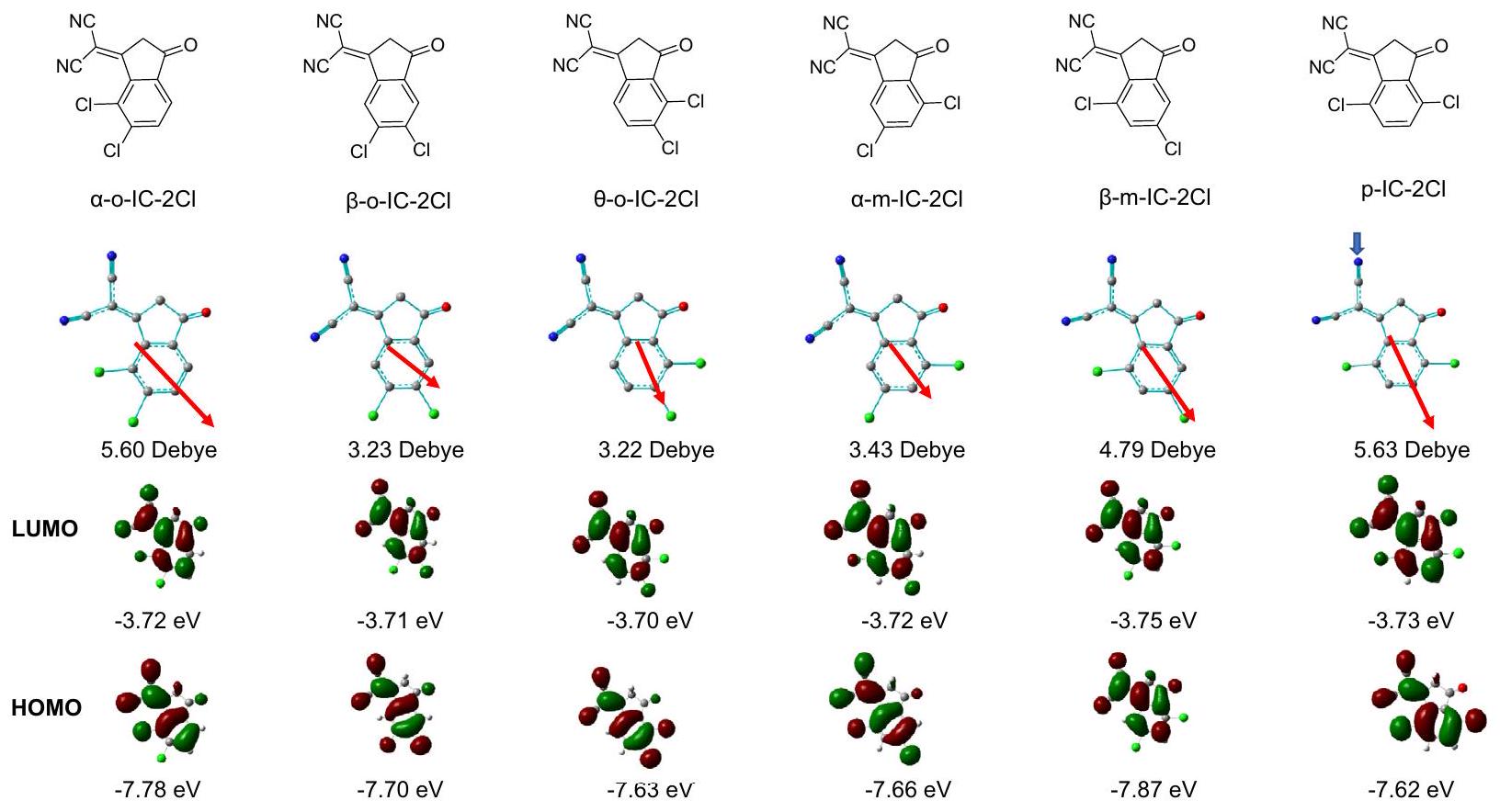
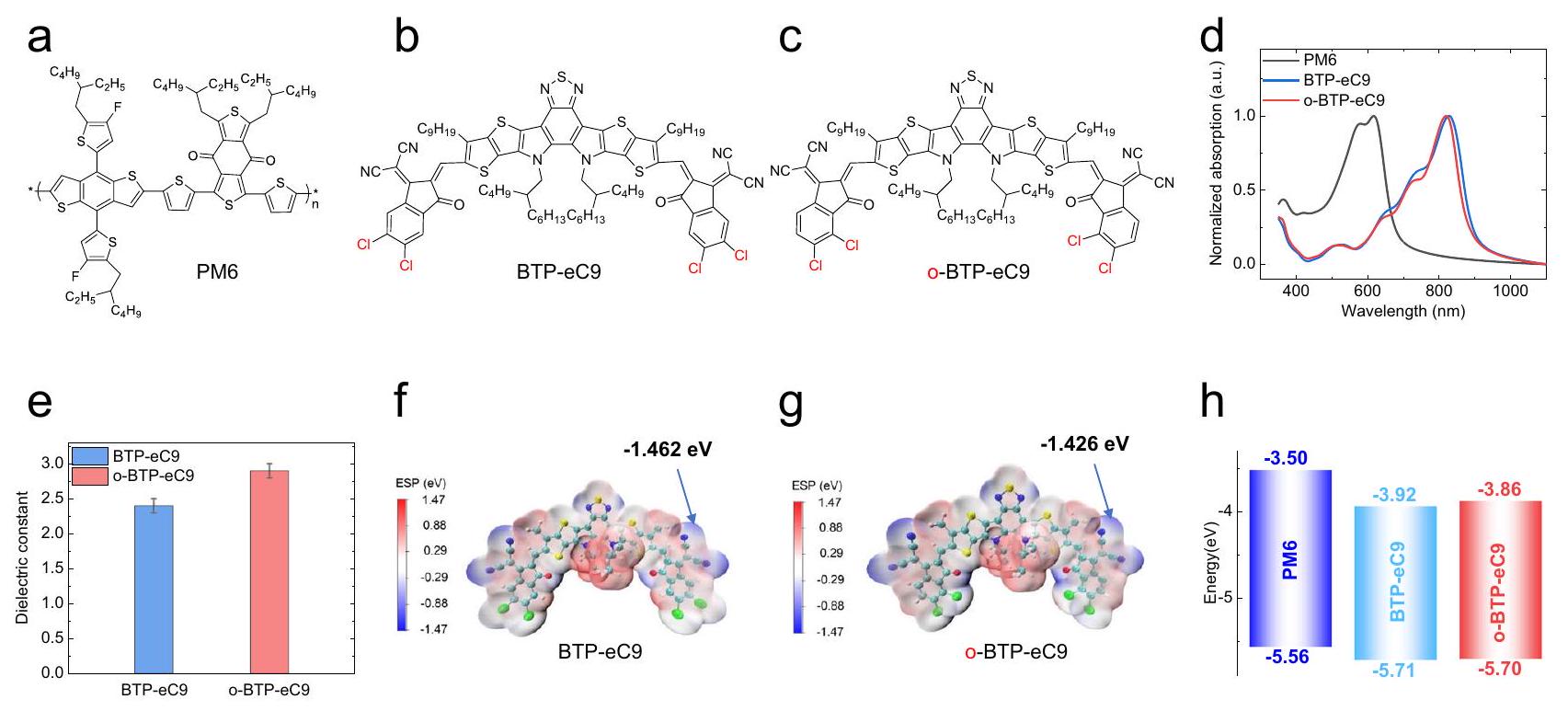
| مستقبل | هومو
|
لو مو
|
|
|
|
|
|
| BTP-eC9 | -5.71 | -3.92 | 1.79 | 746.8 | ٨٢٨.٢ | 908 | 1.37 |
| o-BTP-eC9 | -5.70 | -3.86 | 1.84 | 746.8 | ٨٢٥.٦ | ٨٨٧ | 1.40 |
معادلة
أداء الجهاز للدوائر العضوية الثنائية والثلاثية
قيم عامل الملء (FF) الممتازة حوالي
فيزياء الأجهزة
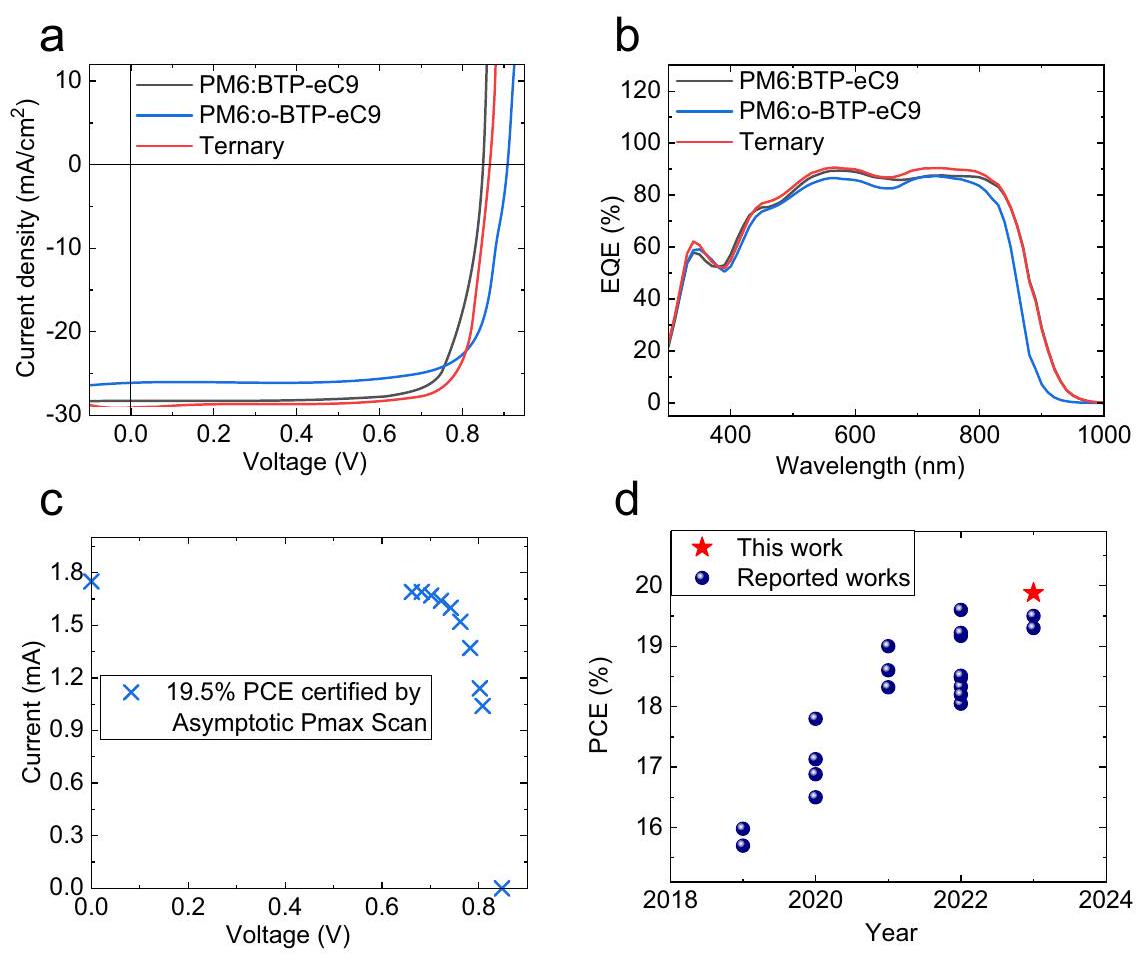
| الطبقة النشطة |
|
|
|
نسبة FF (%) | PCE
|
| PM6:BTP-eC9 | 0.843 | ٢٨.٢٧ | ٢٧.٣٩ | 79.17 |
|
| PM6:o-BTP-eC9 | 0.901 | ٢٦.٣٣ | ٢٥.٥٤ | 78.83 |
|
| ثلاثي | 0.860 | ٢٨.٧٥ | ٢٧.٨٣ | 80.41 |
|
| ثلاثي
|
0.848 | ٢٨.٧٨ | / | 79.86 | 19.48 |
| الطبقة النشطة |
|
|
|
|
|
EQE
|
|
|
| PM6:BTP-eC9 | 0.855 | 0.541 | 1.396 | 0.261 | 0.069 |
|
0.202 | 0.211 |
| PM6:o-BTP-eC9 | 0.913 | 0.500 | 1.413 | 0.263 | 0.048 |
|
0.188 | 0.189 |
| ثلاثي | 0.872 | 0.525 | 1.397 | 0.262 | 0.064 |
|
0.190 | 0.199 |
ال
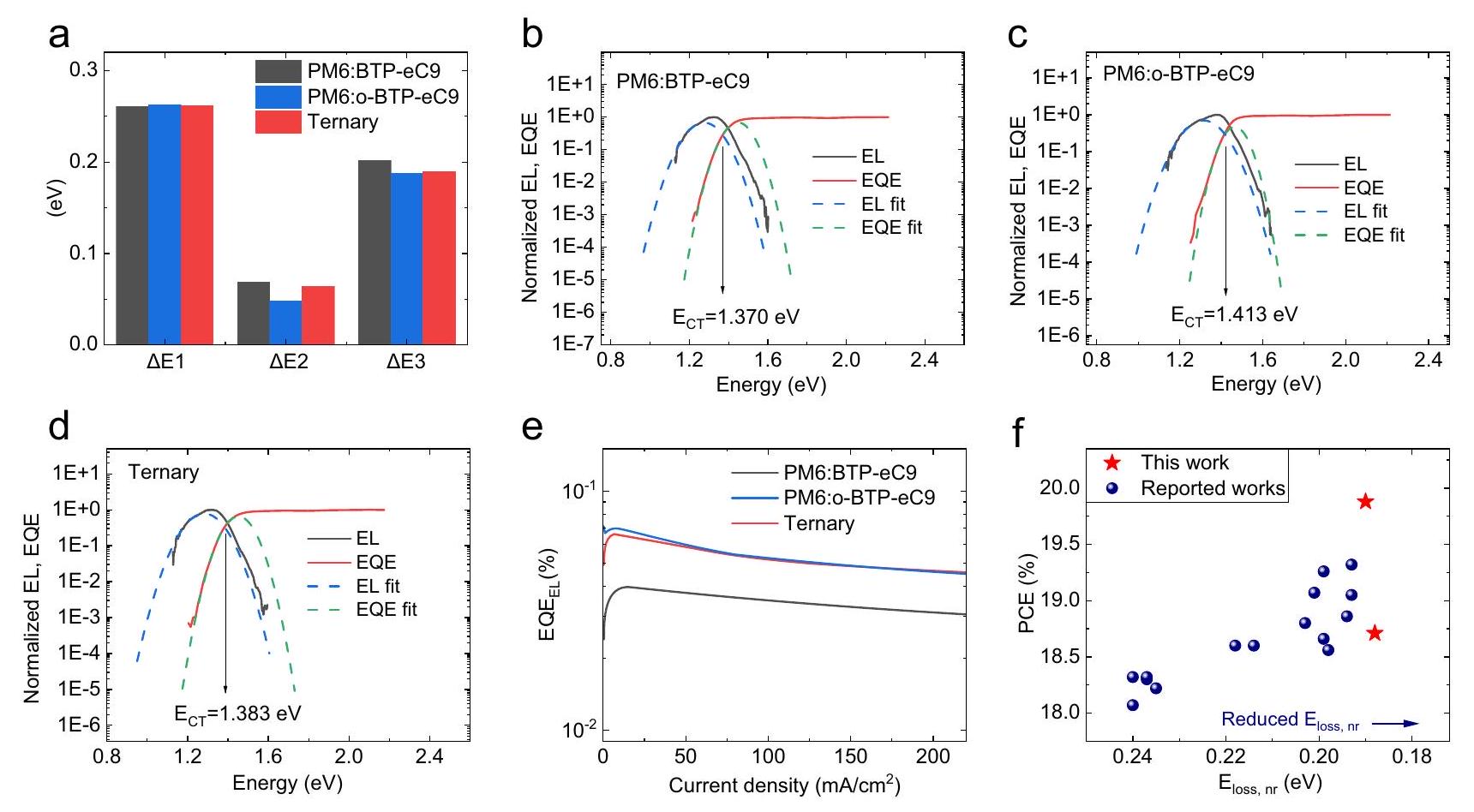
النانومورفولوجيا والتعبئة الجزيئية في أفلام الخلط الثنائي والثلاثي
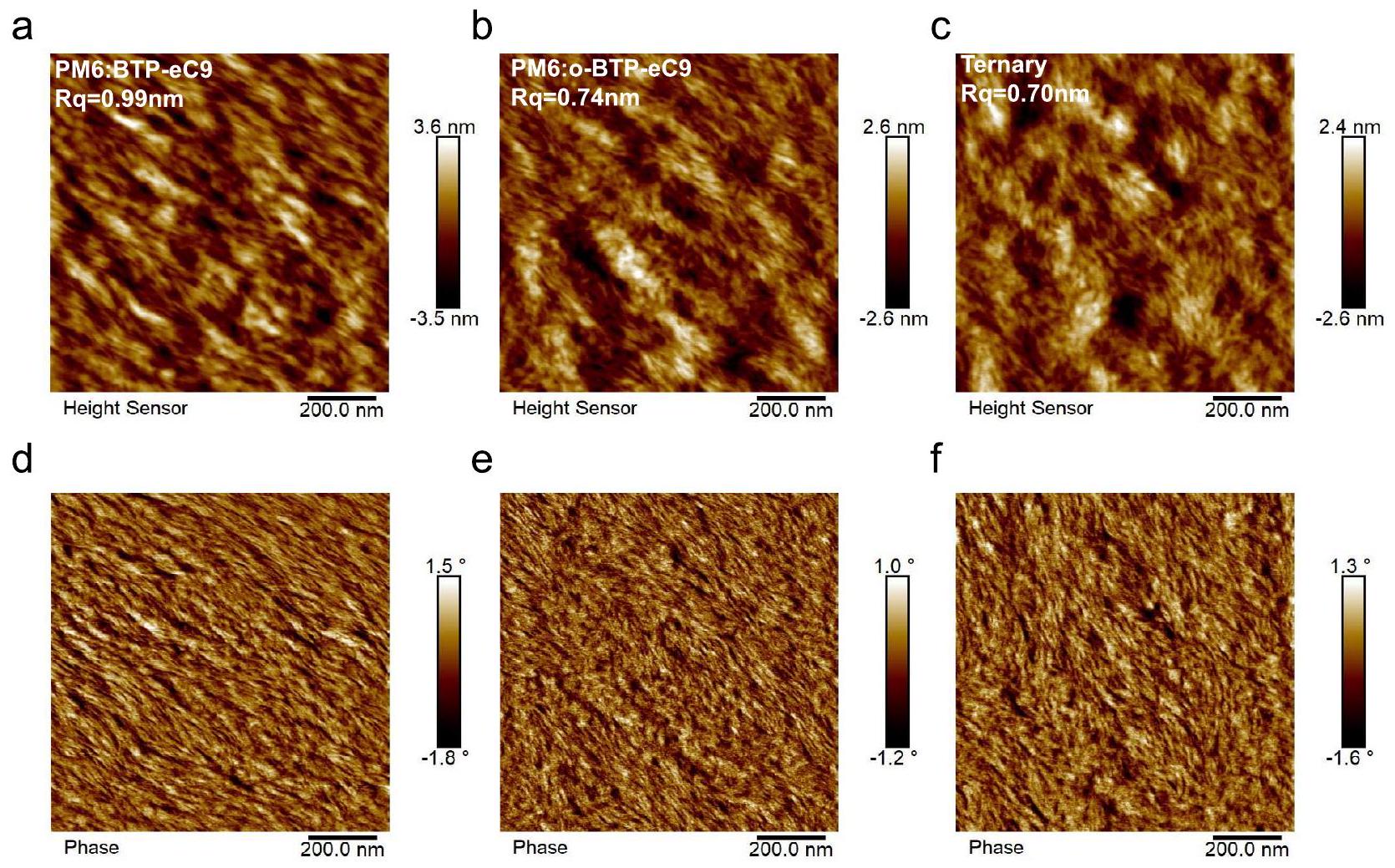
نقاش
تم تحقيق ذلك. يفتح هذا العمل طريقًا لتصميم جزيئات ضيف NFA جديدة نحو خلايا شمسية عضوية عالية الأداء.
طرق
المواد
تصنيع واختبار الأجهزة
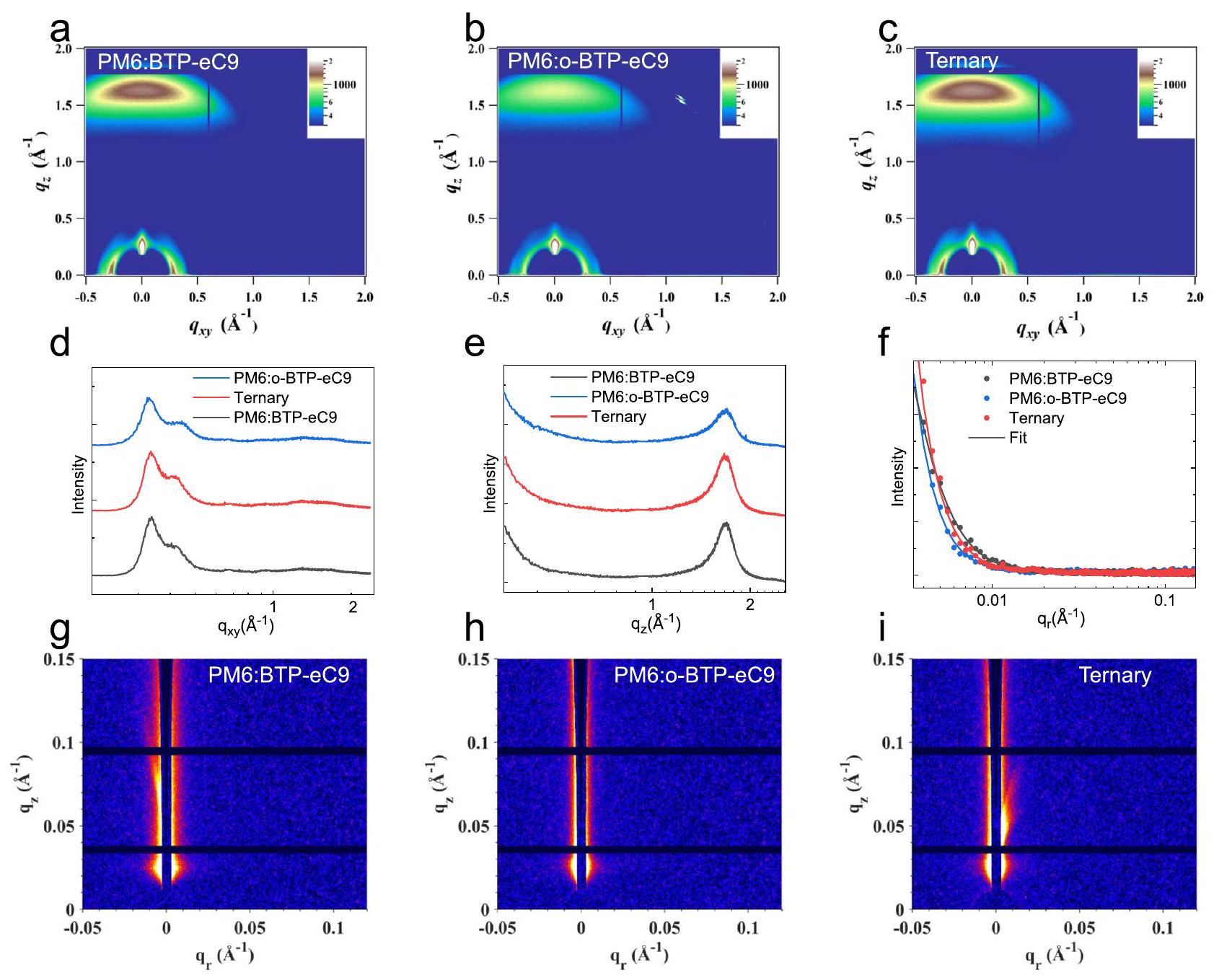
AFM، GIWAXS و GISAXS
ورأسياً (
EQE شديد الحساسية و
ملخص التقرير
توفر البيانات
References
- Lin, Y. et al. An electron acceptor challenging fullerenes for efficient polymer solar cells. Adv. Mater. 27, 1170-1174 (2015).
- Yuan, J. et al. Enabling low voltage losses and high photocurrent in fullerene-free organic photovoltaics. Nat. Commun. 10, 570 (2019).
- Yuan, J. et al. Single-junction organic solar cell with over
efficiency using fused-ring acceptor with electron-deficient core. Joule 3, 1140-1151 (2019). - Cui, Y. et al. Single-junction organic photovoltaic cell with
efficiency. Adv. Mater. 33, 2102420 (2021). - Cui, Y. et al. Single-junction organic photovoltaic cells with approaching 18% efficiency. Adv. Mater. 32, 1908205 (2020).
- Fu, J. et al. 19.31% binary organic solar cell and low non-radiative recombination enabled by non-monotonic intermediate state transition. Nat. Commun. 14, 1760 (2023).
- Zhu, L. et al. Single-junction organic solar cells with over
efficiency enabled by a refined double-fibril network morphology. Nat. Mater. 21, 656-663 (2022). - Menke, S. M., Ran, N. A., Bazan, G. C. & Friend, R. H. Understanding energy loss in organic solar cells: toward a new efficiency regime. Joule 2, 25-35 (2018).
- Vandewal, K., Tvingstedt, K., Gadisa, A., Inganäs, O. & Manca, J. V. On the origin of the open-circuit voltage of polymer-fullerene solar cells. Nat. Mater. 8, 904-909 (2009).
- Gillett, A. J. et al. The role of charge recombination to triplet excitons in organic solar cells. Nature 597, 666-671 (2021).
- Yang, Y. et al. High-performance multiple-donor bulk heterojunction solar cells. Nat. Photon. 9, 190-198 (2015).
- Tang, H. et al. Donor derivative incorporation: an effective strategy toward high performance all-small-molecule ternary organic solar cells. Adv. Sci. 6, 1901613 (2019).
- Gasparini, N. et al. Designing ternary blend bulk heterojunction solar cells with reduced carrier recombination and a fill factor of 77%. Nat. Energy 1, 1-9 (2016).
- Zhang, Y. et al. A novel wide-bandgap polymer with deep ionization potential enables exceeding 16% efficiency in ternary nonfullerene polymer solar cells. Adv. Funct. Mater. 30, 1910466 (2020).
- Baran, D. et al. Reducing the efficiency-stability-cost gap of organic photovoltaics with highly efficient and stable small molecule acceptor ternary solar cells. Nat. Mater. 16, 363-369 (2017).
- Cui, Y. et al. Achieving over
efficiency in organic photovoltaic cells via copolymer design. Adv. Mater. 31, 1808356 (2019). - Zhou, Z. et al. High-efficiency small-molecule ternary solar cells with a hierarchical morphology enabled by synergizing fullerene and non-fullerene acceptors. Nat. Energy 3, 952-959 (2018).
- Günther, M. et al. Models and mechanisms of ternary organic solar cells. Nat. Rev. Mater. 8, 456-471 (2023).
- Yang, Q. et al. Balancing the efficiency and synthetic accessibility of organic solar cells with isomeric acceptor engineering. Adv. Sci. 10, 2207678 (2023).
- Eisner, F. D. et al. Hybridization of local exciton and charge-transfer states reduces nonradiative voltage losses in organic solar cells. J. Am. Chem. Soc. 141, 6362-6374 (2019).
- Qian, D. et al. Design rules for minimizing voltage losses in highefficiency organic solar cells. Nat. Mater. 17, 703-709 (2018).
- Luo, Z. et al. Altering the positions of chlorine and bromine substitution on the end group enables high-performance acceptor and efficient organic solar cells. Adv. Energy Mater. 10, 2002649 (2020).
- Gao, W. et al. Achieving 19% power conversion efficiency in planarmixed heterojunction organic solar cells using a pseudosymmetric electron acceptor. Adv. Mater. 34, 2202089 (2022).
- Li, X. et al. Effect of the chlorine substitution position of the endgroup on intermolecular interactions and photovoltaic performance of small molecule acceptors. Energy Environ. Sci. 13, 5028-5038 (2020).
- Comyn, J. Contact angles and adhesive bonding. Int. J. Adhes. Adhes. 12, 145-149 (1992).
- Pang, S. et al. Alkyl chain length effects of polymer donors on the morphology and device performance of polymer solar cells with different acceptors. Adv. Energy Mater. 9, 1901740 (2019).
- Nilsson, S., Bernasik, A., Budkowski, A. & Moons, E. Morphology and phase segregation of spin-casted films of polyfluorene/PCBM blends. Macromolecules 40, 8291-8301 (2007).
- Bi, P. et al. Reduced non-radiative charge recombination enables organic photovoltaic cell approaching 19% efficiency. Joule 5, 2408-2419 (2021).
- Cai, Y. et al. A well-mixed phase formed by two compatible nonfullerene acceptors enables ternary organic solar cells with efficiency over
. Adv. Mater. 33, 2101733 (2021). - Fu, J. et al. Eutectic phase behavior induced by a simple additive contributes to efficient organic solar cells. Nano Energy 84, 105862 (2021).
- Song, T., Friedman, D. J. & Kopidakis, N. How useful are conventional I-Vs for performance calibration of single-and two-junction perovskite solar cells? A statistical analysis of performance data on
cells from 30 global sources. Sol. RRL 6, 2100867 (2022). - Moriarty, T. & Levi, D. in 2017 IEEE 44th Photovoltaic Specialist Conference (PVSC) 483-486 (IEEE, 2017).
- Yao, J. et al. Quantifying losses in open-circuit voltage in solutionprocessable solar cells. Phys. Rev. Appl. 4, 014020 (2015).
- Shockley, W. & Queisser, H. J. Detailed balance limit of efficiency of p-n junction solar cells. J. Appl. Phys. 32, 510-519 (1961).
- Liu, J. et al. Fast charge separation in a non-fullerene organic solar cell with a small driving force. Nat. Energy 1, 16089 (2016).
- Faist, M. A. et al. Competition between the charge transfer state and the singlet states of donor or acceptor limiting the efficiency in polymer: fullerene solar cells. J. Am. Chem. Soc. 134, 685-692 (2012).
- Rau, U. Reciprocity relation between photovoltaic quantum efficiency and electroluminescent emission of solar cells. Phys. Rev. B 76, 085303 (2007).
- Rau, U., Blank, B., Müller, T. C. & Kirchartz, T. Efficiency potential of photovoltaic materials and devices unveiled by detailed-balance analysis. Phys. Rev. Appl. 7, 044016 (2017).
- Wang, Y. et al. Optical gaps of organic solar cells as a reference for comparing voltage losses. Adv. Energy Mater. 8, 1801352 (2018).
- Fu, J. H. et al. A “sigma-Hole”-containing volatile solid additive enabling 16.5% efficiency organic solar cells. iScience 23, 100965 (2020).
- Kyaw, A. K. K. et al. Intensity dependence of current-voltage characteristics and recombination in high-efficiency solution-processed small-molecule solar cells. ACS Nano 7, 4569-4577 (2013).
- Lv, J. et al. Energetic disorder and activation energy in efficient ternary organic solar cells with nonfullerene acceptor Eh-IDTBR as the third component. Sol. RRL 4, 1900403 (2019).
- Fan, B. et al. Optimisation of processing solvent and molecular weight for the production of green-solvent-processed all-polymer
solar cells with a power conversion efficiency over 9%. Energy Environ. Sci. 10, 1243-1251 (2017). - Wehenkel, D. J., Koster, L. J. A., Wienk, M. M. & Janssen, R. A. Influence of injected charge carriers on photocurrents in polymer solar cells. Phys. Rev. B 85, 125203 (2012).
- Xiao, Y. & Lu, X. Morphology of organic photovoltaic non-fullerene acceptors investigated by grazing incidence X-ray scattering techniques. Mater. Today Nano 5, 100030 (2019).
- Rivnay, J., Mannsfeld, S. C., Miller, C. E., Salleo, A. & Toney, M. F. Quantitative determination of organic semiconductor microstructure from the molecular to device scale. Chem. Rev. 112, 5488-5519 (2012).
شكر وتقدير
مساهمات المؤلفين
Y.Y. و G.L. قادا الموضوع وراجعا المخطوطة. ناقش جميع المؤلفين النتائج وعلقوا على المخطوطة.
المصالح المتنافسة
معلومات إضافية
المواد التكميلية متاحة على
https://doi.org/10.1038/s41467-024-46022-3.
يجب توجيه المراسلات والطلبات للحصول على المواد إلى شيرونغ لو، زيون شياو أو غانغ لي.
http://www.nature.com/reprints
(ج) المؤلفون 2024
قسم الهندسة الكهربائية والإلكترونية، معهد الأبحاث للطاقة الذكية (RISE)، معهد الأبحاث الضوئية (PRI)، جامعة بوليتكنك هونغ كونغ، هونغ هوم، كولون، هونغ كونغ 999077، جمهورية الصين الشعبية. كلية علوم المواد والهندسة، جامعة تايتشو، تايتشو 318000، جمهورية الصين الشعبية. مركز أبحاث تكنولوجيا خلايا الشمسية الرقيقة، معهد تشونغتشينغ للتكنولوجيا الخضراء والذكية، مدرسة تشونغتشينغ، أكاديمية الصين للعلوم (تشونغتشينغ UCAS)، الأكاديمية الصينية للعلوم، تشونغتشينغ 400714، جمهورية الصين الشعبية. جامعة الأكاديمية الصينية للعلوم، 100049 بكين، جمهورية الصين الشعبية. قسم الهندسة الكيميائية، جامعة بوهانغ للعلوم والتكنولوجيا، بوهانغ 37673، كوريا الجنوبية. مدرسة العلوم الفيزيائية والتكنولوجيا، جامعة قويتشو، ناننينغ 530004، جمهورية الصين الشعبية. قسم الفيزياء، الجامعة الصينية في هونغ كونغ، شاتين، هونغ كونغ 999077، جمهورية الصين الشعبية. معهد شنتشن غروبز وقسم الكيمياء، جامعة العلوم والتكنولوجيا الجنوبية، شنتشن 518055، جمهورية الصين الشعبية. قسم علوم المواد والهندسة، جامعة كاليفورنيا لوس أنجلوس (UCLA)، لوس أنجلوس، كاليفورنيا 90095، الولايات المتحدة الأمريكية. ساهم هؤلاء المؤلفون بالتساوي: جيهاو فو، تشيانغوانغ يانغ. البريد الإلكتروني:lushirong@cigit.ac.cn; xiao.z@cigit.ac.cn; gang.w.li@polyu.edu.hk
DOI: https://doi.org/10.1038/s41467-024-46022-3
PMID: https://pubmed.ncbi.nlm.nih.gov/38418862
Publication Date: 2024-02-28
Rational molecular and device design enables organic solar cells approaching 20% efficiency
Accepted: 12 February 2024
Published online: 28 February 2024
(A) Check for updates
Abstract
For organic solar cells to be competitive, the light-absorbing molecules should simultaneously satisfy multiple key requirements, including weak-absorption charge transfer state, high dielectric constant, suitable surface energy, proper crystallinity, etc. However, the systematic design rule in molecules to achieve the abovementioned goals is rarely studied. In this work, guided by theoretical calculation, we present a rational design of non-fullerene acceptor o-BTP-eC9, with distinct photoelectric properties compared to benchmark BTP-eC9. o-BTP-eC9 based device has uplifted charge transfer state, therefore significantly reducing the energy loss by 41 meV and showing excellent power conversion efficiency of
and improving the electroluminescence quantum efficiency (
Results
Theoretical calculation and the intrinsic properties of target molecule
influencing the LUMO electron distribution of NFA molecule. According to the intensity borrowing mechanism, uplifting the LUMO level of NFA is an effective method to suppress the


| Acceptor | HOMO
|
LOMO
|
|
|
|
|
|
| BTP-eC9 | -5.71 | -3.92 | 1.79 | 746.8 | 828.2 | 908 | 1.37 |
| o-BTP-eC9 | -5.70 | -3.86 | 1.84 | 746.8 | 825.6 | 887 | 1.40 |
equation of
Device performance of binary and ternary OSCs
excellent fill factor (FF) values of around
Device physics

| Active layer |
|
|
|
FF (%) | PCE
|
| PM6:BTP-eC9 | 0.843 | 28.27 | 27.39 | 79.17 |
|
| PM6:o-BTP-eC9 | 0.901 | 26.33 | 25.54 | 78.83 |
|
| Ternary | 0.860 | 28.75 | 27.83 | 80.41 |
|
| Ternary
|
0.848 | 28.78 | / | 79.86 | 19.48 |
| Active layer |
|
|
|
|
|
EQE
|
|
|
| PM6:BTP-eC9 | 0.855 | 0.541 | 1.396 | 0.261 | 0.069 |
|
0.202 | 0.211 |
| PM6:o-BTP-eC9 | 0.913 | 0.500 | 1.413 | 0.263 | 0.048 |
|
0.188 | 0.189 |
| Ternary | 0.872 | 0.525 | 1.397 | 0.262 | 0.064 |
|
0.190 | 0.199 |
the

Nano-morphology and molecular packing in binary and ternary blend films

Discussion
achieved. This work paves an avenue for designing new NFA guest molecules toward high performance OSCs.
Methods
Materials
Device fabrication and testing

AFM, GIWAXS and GISAXS
and vertically (
Highly sensitive EQE and
Reporting summary
Data availability
References
- Lin, Y. et al. An electron acceptor challenging fullerenes for efficient polymer solar cells. Adv. Mater. 27, 1170-1174 (2015).
- Yuan, J. et al. Enabling low voltage losses and high photocurrent in fullerene-free organic photovoltaics. Nat. Commun. 10, 570 (2019).
- Yuan, J. et al. Single-junction organic solar cell with over
efficiency using fused-ring acceptor with electron-deficient core. Joule 3, 1140-1151 (2019). - Cui, Y. et al. Single-junction organic photovoltaic cell with
efficiency. Adv. Mater. 33, 2102420 (2021). - Cui, Y. et al. Single-junction organic photovoltaic cells with approaching 18% efficiency. Adv. Mater. 32, 1908205 (2020).
- Fu, J. et al. 19.31% binary organic solar cell and low non-radiative recombination enabled by non-monotonic intermediate state transition. Nat. Commun. 14, 1760 (2023).
- Zhu, L. et al. Single-junction organic solar cells with over
efficiency enabled by a refined double-fibril network morphology. Nat. Mater. 21, 656-663 (2022). - Menke, S. M., Ran, N. A., Bazan, G. C. & Friend, R. H. Understanding energy loss in organic solar cells: toward a new efficiency regime. Joule 2, 25-35 (2018).
- Vandewal, K., Tvingstedt, K., Gadisa, A., Inganäs, O. & Manca, J. V. On the origin of the open-circuit voltage of polymer-fullerene solar cells. Nat. Mater. 8, 904-909 (2009).
- Gillett, A. J. et al. The role of charge recombination to triplet excitons in organic solar cells. Nature 597, 666-671 (2021).
- Yang, Y. et al. High-performance multiple-donor bulk heterojunction solar cells. Nat. Photon. 9, 190-198 (2015).
- Tang, H. et al. Donor derivative incorporation: an effective strategy toward high performance all-small-molecule ternary organic solar cells. Adv. Sci. 6, 1901613 (2019).
- Gasparini, N. et al. Designing ternary blend bulk heterojunction solar cells with reduced carrier recombination and a fill factor of 77%. Nat. Energy 1, 1-9 (2016).
- Zhang, Y. et al. A novel wide-bandgap polymer with deep ionization potential enables exceeding 16% efficiency in ternary nonfullerene polymer solar cells. Adv. Funct. Mater. 30, 1910466 (2020).
- Baran, D. et al. Reducing the efficiency-stability-cost gap of organic photovoltaics with highly efficient and stable small molecule acceptor ternary solar cells. Nat. Mater. 16, 363-369 (2017).
- Cui, Y. et al. Achieving over
efficiency in organic photovoltaic cells via copolymer design. Adv. Mater. 31, 1808356 (2019). - Zhou, Z. et al. High-efficiency small-molecule ternary solar cells with a hierarchical morphology enabled by synergizing fullerene and non-fullerene acceptors. Nat. Energy 3, 952-959 (2018).
- Günther, M. et al. Models and mechanisms of ternary organic solar cells. Nat. Rev. Mater. 8, 456-471 (2023).
- Yang, Q. et al. Balancing the efficiency and synthetic accessibility of organic solar cells with isomeric acceptor engineering. Adv. Sci. 10, 2207678 (2023).
- Eisner, F. D. et al. Hybridization of local exciton and charge-transfer states reduces nonradiative voltage losses in organic solar cells. J. Am. Chem. Soc. 141, 6362-6374 (2019).
- Qian, D. et al. Design rules for minimizing voltage losses in highefficiency organic solar cells. Nat. Mater. 17, 703-709 (2018).
- Luo, Z. et al. Altering the positions of chlorine and bromine substitution on the end group enables high-performance acceptor and efficient organic solar cells. Adv. Energy Mater. 10, 2002649 (2020).
- Gao, W. et al. Achieving 19% power conversion efficiency in planarmixed heterojunction organic solar cells using a pseudosymmetric electron acceptor. Adv. Mater. 34, 2202089 (2022).
- Li, X. et al. Effect of the chlorine substitution position of the endgroup on intermolecular interactions and photovoltaic performance of small molecule acceptors. Energy Environ. Sci. 13, 5028-5038 (2020).
- Comyn, J. Contact angles and adhesive bonding. Int. J. Adhes. Adhes. 12, 145-149 (1992).
- Pang, S. et al. Alkyl chain length effects of polymer donors on the morphology and device performance of polymer solar cells with different acceptors. Adv. Energy Mater. 9, 1901740 (2019).
- Nilsson, S., Bernasik, A., Budkowski, A. & Moons, E. Morphology and phase segregation of spin-casted films of polyfluorene/PCBM blends. Macromolecules 40, 8291-8301 (2007).
- Bi, P. et al. Reduced non-radiative charge recombination enables organic photovoltaic cell approaching 19% efficiency. Joule 5, 2408-2419 (2021).
- Cai, Y. et al. A well-mixed phase formed by two compatible nonfullerene acceptors enables ternary organic solar cells with efficiency over
. Adv. Mater. 33, 2101733 (2021). - Fu, J. et al. Eutectic phase behavior induced by a simple additive contributes to efficient organic solar cells. Nano Energy 84, 105862 (2021).
- Song, T., Friedman, D. J. & Kopidakis, N. How useful are conventional I-Vs for performance calibration of single-and two-junction perovskite solar cells? A statistical analysis of performance data on
cells from 30 global sources. Sol. RRL 6, 2100867 (2022). - Moriarty, T. & Levi, D. in 2017 IEEE 44th Photovoltaic Specialist Conference (PVSC) 483-486 (IEEE, 2017).
- Yao, J. et al. Quantifying losses in open-circuit voltage in solutionprocessable solar cells. Phys. Rev. Appl. 4, 014020 (2015).
- Shockley, W. & Queisser, H. J. Detailed balance limit of efficiency of p-n junction solar cells. J. Appl. Phys. 32, 510-519 (1961).
- Liu, J. et al. Fast charge separation in a non-fullerene organic solar cell with a small driving force. Nat. Energy 1, 16089 (2016).
- Faist, M. A. et al. Competition between the charge transfer state and the singlet states of donor or acceptor limiting the efficiency in polymer: fullerene solar cells. J. Am. Chem. Soc. 134, 685-692 (2012).
- Rau, U. Reciprocity relation between photovoltaic quantum efficiency and electroluminescent emission of solar cells. Phys. Rev. B 76, 085303 (2007).
- Rau, U., Blank, B., Müller, T. C. & Kirchartz, T. Efficiency potential of photovoltaic materials and devices unveiled by detailed-balance analysis. Phys. Rev. Appl. 7, 044016 (2017).
- Wang, Y. et al. Optical gaps of organic solar cells as a reference for comparing voltage losses. Adv. Energy Mater. 8, 1801352 (2018).
- Fu, J. H. et al. A “sigma-Hole”-containing volatile solid additive enabling 16.5% efficiency organic solar cells. iScience 23, 100965 (2020).
- Kyaw, A. K. K. et al. Intensity dependence of current-voltage characteristics and recombination in high-efficiency solution-processed small-molecule solar cells. ACS Nano 7, 4569-4577 (2013).
- Lv, J. et al. Energetic disorder and activation energy in efficient ternary organic solar cells with nonfullerene acceptor Eh-IDTBR as the third component. Sol. RRL 4, 1900403 (2019).
- Fan, B. et al. Optimisation of processing solvent and molecular weight for the production of green-solvent-processed all-polymer
solar cells with a power conversion efficiency over 9%. Energy Environ. Sci. 10, 1243-1251 (2017). - Wehenkel, D. J., Koster, L. J. A., Wienk, M. M. & Janssen, R. A. Influence of injected charge carriers on photocurrents in polymer solar cells. Phys. Rev. B 85, 125203 (2012).
- Xiao, Y. & Lu, X. Morphology of organic photovoltaic non-fullerene acceptors investigated by grazing incidence X-ray scattering techniques. Mater. Today Nano 5, 100030 (2019).
- Rivnay, J., Mannsfeld, S. C., Miller, C. E., Salleo, A. & Toney, M. F. Quantitative determination of organic semiconductor microstructure from the molecular to device scale. Chem. Rev. 112, 5488-5519 (2012).
Acknowledgements
Author contributions
Y.Y., and G.L. directed the subject and revised the manuscript. All authors discussed the results and commented on the manuscript.
Competing interests
Additional information
supplementary material available at
https://doi.org/10.1038/s41467-024-46022-3.
Correspondence and requests for materials should be addressed to Shirong Lu, Zeyun Xiao or Gang Li.
http://www.nature.com/reprints
(c) The Author(s) 2024
Department of Electrical and Electronic Engineering, Research Institute for Smart Energy (RISE), Photonic Research Institute (PRI), The Hong Kong Polytechnic University, Hung Hom, Kowloon, Hong Kong 999077, PR China. School of Materials Science and Engineering, Taizhou University, Taizhou 318000, PR China. Thin-Film Solar Cell Technology Research Center, Chongqing Institute of Green and Intelligent Technology, Chongqing School, University of Chinese Academy of Sciences (UCAS Chongqing), Chinese Academy of Sciences, Chongqing 400714, PR China. University of Chinese Academy of Sciences, 100049 Beijing, PR China. Department of Chemical Engineering, Pohang University of Science and Technology, Pohang 37673, South Korea. School of Physical Science and Technology, Guangxi University, Nanning 530004, PR China. Department of Physics, The Chinese University of Hong Kong, Shatin, Hong Kong 999077, PR China. Shenzhen Grubbs Institute and Department of Chemistry, Southern University of Science and Technology, Shenzhen 518055, PR China. Department of Materials Science and Engineering, University of California Los Angeles (UCLA), Los Angeles, CA 90095, USA. These authors contributed equally: Jiehao Fu, Qianguang Yang. e-mail: lushirong@cigit.ac.cn; xiao.z@cigit.ac.cn; gang.w.li@polyu.edu.hk
